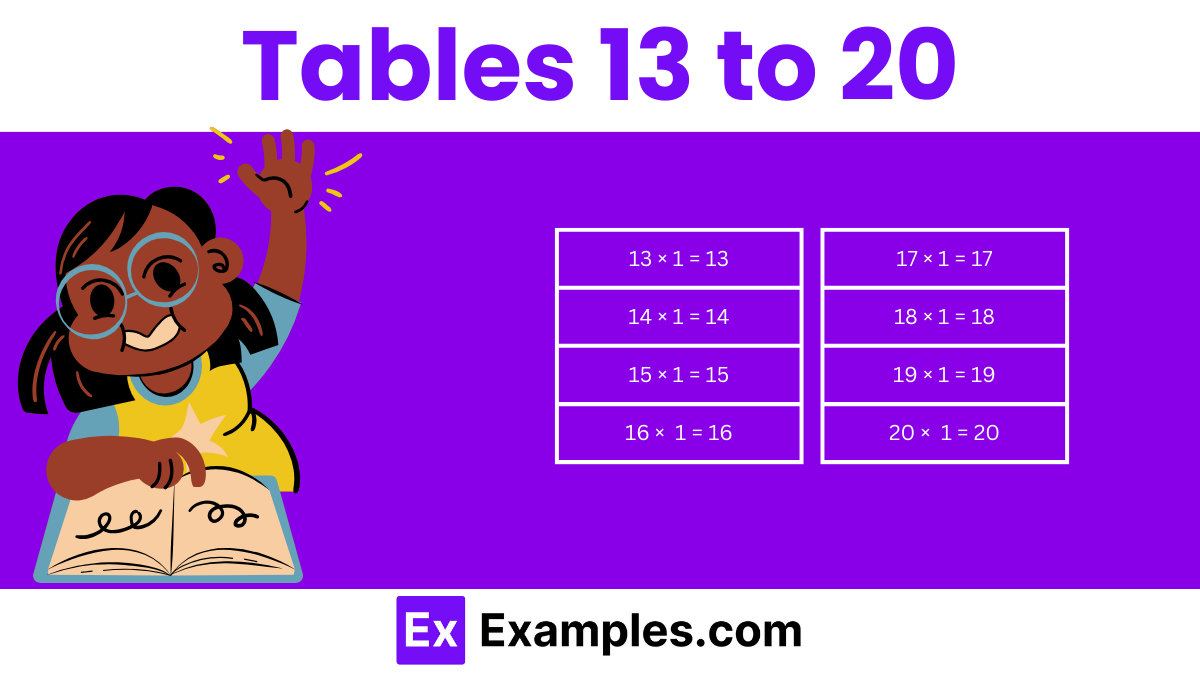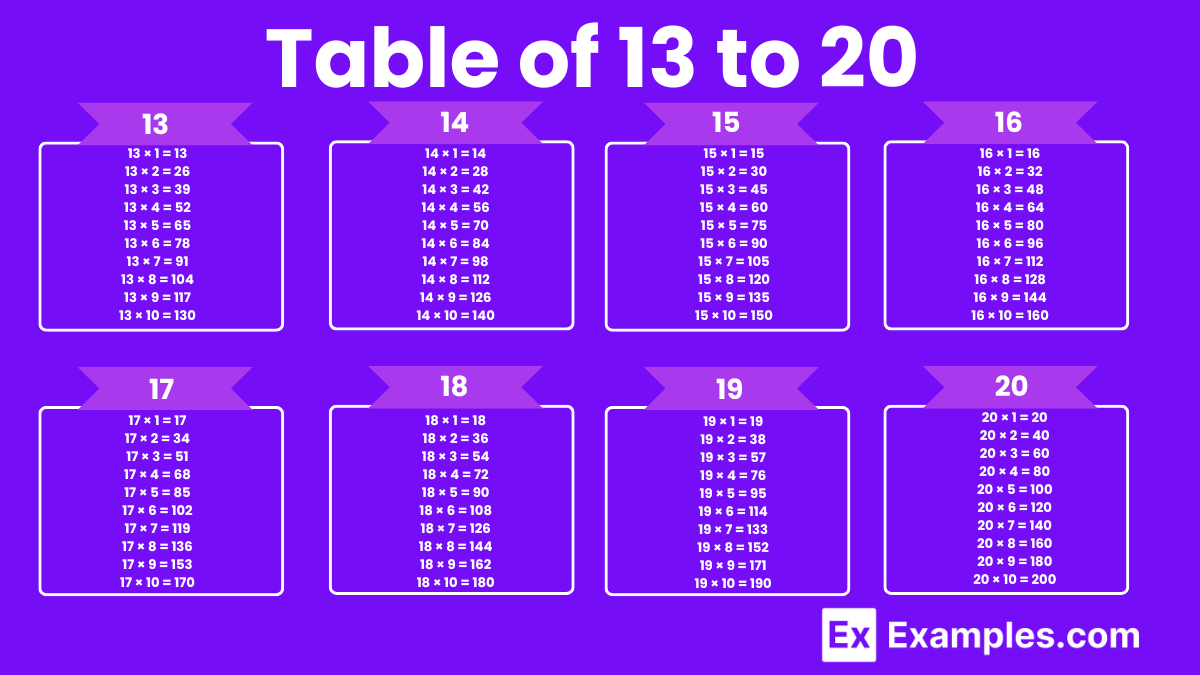What number should be multiplied with 15 to get 225?
13
14
15
16


The multiplication chart for tables 13 to 20 provides a structured mathematical format to aid in the efficient memorization and application of higher multiplication facts, essential for advanced mathematical proficiency and problem-solving skills.

Download Tables From 13 to 20 Chart Pdf
The multiplication chart for tables from 13 to 20 includes a clear, mathematical format that effectively aids students in mastering these higher tables. This chart systematically displays the products of numbers between 13 and 20, arranged in a grid format to facilitate easy lookup and reference. It serves as a crucial tool for older students or those in advanced math classes, enabling them to quickly perform and verify multiplication operations, which are fundamental in various mathematical contexts such as algebra, geometry, and beyond
Download Tables From 13 to 20 Chart Pdf
| 13 Table | 14 Table | 15 Table | 16 Table |
|---|---|---|---|
| 13 x 1 = 13 | 14 x 1 = 14 | 15 x 1 = 15 | 16 x 1 = 16 |
| 13 x 2 = 26 | 14 x 2 = 28 | 15 x 2 = 30 | 16 x 2 = 32 |
| 13 x 3 = 39 | 14 x 3 = 42 | 15 x 3 = 45 | 16 x 3 = 48 |
| 13 x 4 = 52 | 14 x 4 = 56 | 15 x 4 = 60 | 16 x 4 = 64 |
| 13 x 5 = 65 | 14 x 5 = 70 | 15 x 5 = 75 | 16 x 5 = 80 |
| 13 x 6 = 78 | 14 x 6 = 84 | 15 x 6 = 90 | 16 x 6 = 96 |
| 13 x 7 = 91 | 14 x 7 = 98 | 15 x 7 = 105 | 16 x 7 = 112 |
| 13 x 8 = 104 | 14 x 8 = 112 | 15 x 8 = 120 | 16 x 8 = 128 |
| 13 x 9 = 117 | 14 x 9 = 126 | 15 x 9 = 135 | 16 x 9 = 144 |
| 13 x 10 = 130 | 14 x 10 = 140 | 15 x 10 = 150 | 16 x 10 = 160 |
| 17 Table | 18 Table | 19 Table | 20 Table |
|---|---|---|---|
| 17 x 1 = 17 | 18 x 1 = 18 | 19 x 1 = 19 | 20 x 1 = 20 |
| 17 x 2 = 34 | 18 x 2 = 36 | 19 x 2 = 38 | 20 x 2 = 40 |
| 17 x 3 = 51 | 18 x 3 = 54 | 19 x 3 = 57 | 20 x 3 = 60 |
| 17 x 4 = 68 | 18 x 4 = 72 | 19 x 4 = 76 | 20 x 4 = 80 |
| 17 x 5 = 85 | 18 x 5 = 90 | 19 x 5 = 95 | 20 x 5 = 100 |
| 17 x 6 = 102 | 18 x 6 = 108 | 19 x 6 = 114 | 20 x 6 = 120 |
| 17 x 7 = 119 | 18 x 7 = 126 | 19 x 7 = 133 | 20 x 7 = 140 |
| 17 x 8 = 136 | 18 x 8 = 144 | 19 x 8 = 152 | 20 x 8 = 160 |
| 17 x 9 = 153 | 18 x 9 = 162 | 19 x 9 = 171 | 20 x 9 = 180 |
| 17 x 10 = 170 | 18 x 10 = 180 | 19 x 10 = 190 | 20 x 10 = 200 |
Problem: 13 x 3 = ?
Solution: 13 x 3 = 39 (Multiplying 13 by 3 yields 39.)
Problem: 14 x 4 = ?
Solution: 14 x 4 = 56 (Fourteen times four equals fifty-six.)
Problem: 15 x 5 = ?
Solution: 15 x 5 = 75 (Fifteen multiplied by five results in seventy-five.)
Problem: 16 x 6 = ?
Solution: 16 x 6 = 96 (Sixteen times six equals ninety-six.)
Problem: 17 x 7 = ?
Solution: 17 x 7 = 119 (Seventeen times seven equals one hundred nineteen.)
Problem: 18 x 8 = ?
Solution: 18 x 8 = 144 (Eighteen times eight equals one hundred forty-four.)
Problem: 19 x 9 = ?
Solution: 19 x 9 = 171 (Nineteen times nine yields one hundred seventy-one.)
Problem: 20 x 10 = ?
Solution: 20 x 10 = 200 (Twenty times ten equals two hundred.)
Multiplication tables from 13 to 20 are crucial because they extend the basic knowledge of multiplication beyond the more commonly memorized tables up to 12. This range is particularly helpful in advanced mathematical calculations and practical applications like financial planning, measurement conversions, and more complex computational tasks.
Knowing these tables can be incredibly beneficial in many scenarios, such as:
Absolutely! Proficiency in these tables can significantly speed up calculations in competitive exams such as SAT, ACT, GRE, or GMAT, where time management is crucial. Quick mental math allows more time for complex problem-solving.
1. Gradual Introduction: Start with familiar tables and gradually introduce the higher ones to avoid overwhelming students.
2. Interactive Tools: Use visual aids, interactive tools, and gamification to make learning engaging.
3. Real-World Problems: Apply these tables in real-world problems to show their practical value, enhancing student interest and understanding.
Text prompt
Add Tone
10 Examples of Public speaking
20 Examples of Gas lighting
What number should be multiplied with 15 to get 225?
13
14
15
16
If 18 is multiplied by which number, the result is 306?
16
17
18
19
What is the missing number: 14 × _ = 196?
12
13
14
15
If 17 times a number equals 238, what is the number?
14
15
16
17
What is the product of 13 and the sum of 6 and 5?
130
143
154
169
How many times does 20 fit into 340?
16
17
18
19
Which of the following numbers is a multiple of 19?
361
370
389
395
What is the missing number: 19 × _ = 285?
14
15
16
17
What number should be multiplied with 16 to get 256?
14
15
16
17
If 17 is multiplied by which number, the result is 289?
16
17
18
19
Before you leave, take our quick quiz to enhance your learning!

